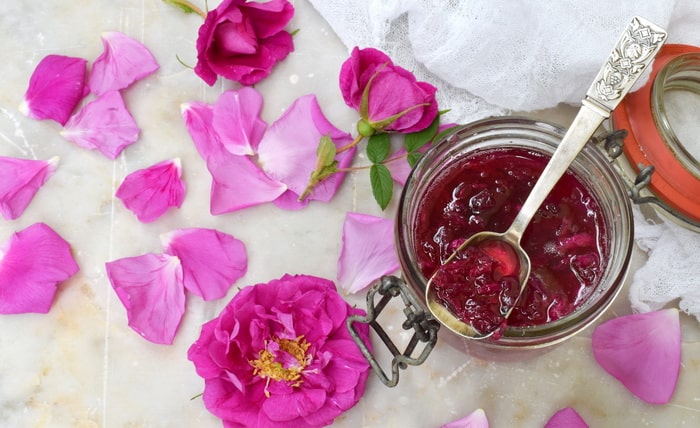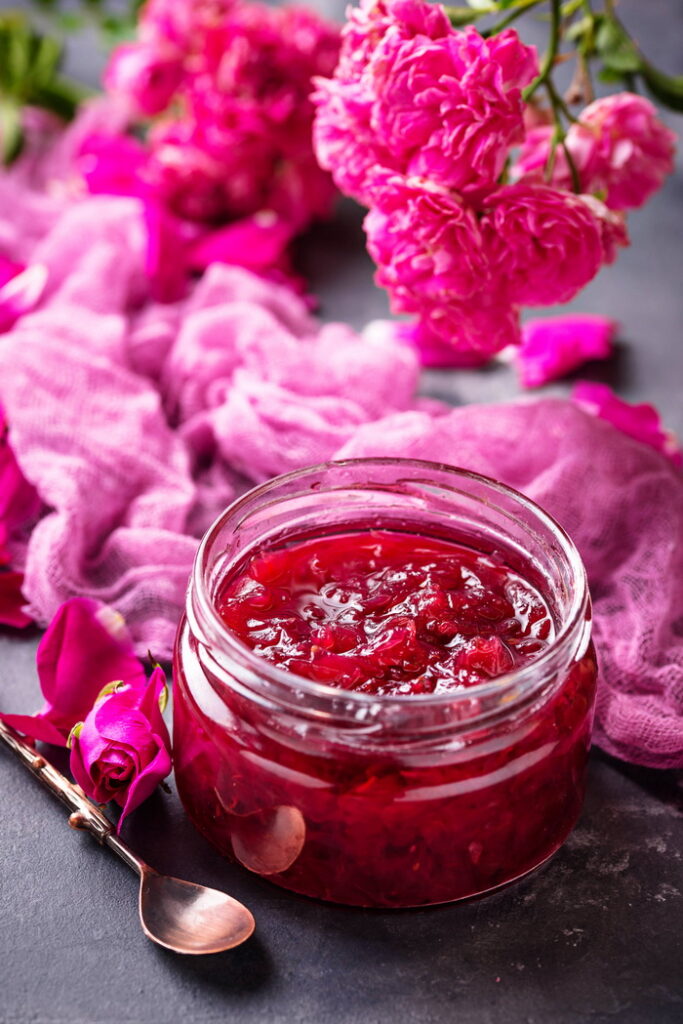Rose jam is made from the petals of old garden roses like the apothecary rose and the damask rose. These roses are bushy and fragrant, loaded with blooms in early summer. These are the roses of history, and spreading your toast or scones with a spoonful of this jam is like stepping back to a simpler time.

What is rose jam?
Rose jam is made from the petals of fragrant roses. While it can be made with dried roses, the flavor is best when made with freshly picked roses from your own organic garden. There are just 4 ingredients — rose petals, lemon juice, sugar, and pectin, plus water.
Rose petal jam is traditional in the Middle East where fragrant rose water is an important aspect of hospitality and culture. Rose petal jam is also traditionally made in the Balkans, Greece, and Italy where fragrant roses were part of the ancient herbal apothecary.
Which roses to use?
When I brought home my apothecary roses (Rosa gallica), Charles de Milles roses, and Rose de Rescht roses from the Fraser Valley Rose Farm one of my goals was to make this sweet, floral, rose petal jam. We planted the roses in 2019 and after 3 years they are thriving and just loaded with blooms. Don’t use florist roses for this recipe. Florist roses are highly sprayed with toxic pesticides and fungicides and are not safe to eat.
For rose jam use fragrant, organically grown roses that are harvested early in the morning before the sun is hot. This is when the fragrance is strongest in the roses and the rose oil in the petals is most intense. Pick the fully-open rose by pinching off the stem just below the calyx of the rose, taking the whole rose blossom in your hand and placing it in a gathering basket. Pick the fresh roses that have just opened. The roses from the previous day will already be fading, and their petals falling off, leave those to form rose hips in the fall. Watch out for garden spiders and honeybees though. These also enjoy the pollen from the open roses and might be hiding in the center of your bloom. I leave those occupied flowers for the pollinators to enjoy.
Cleaning the roses
Remove the roses from your basket and gently pluck the petals from each flower. Apothecary roses have open petals that are easy to pluck from the center of the rose. The Charles de Mille rose is a tighter, multi-petaled blossom with no stamens, but high fragrance. These need to be gently teased apart to release the petals. Traditionally each heart-shaped rose petal is trimmed of the slightly bitter white tip. I left the white tips intact and included the whole petal in my jam.
Remove any green leaves, bugs, and debris from your rose petals as you sort them.
Measure the roses into a measuring cup by gently pressing down the petals into the cup, to get as many petals as possible. Place 4 cups of rose petals into a large mixing bowl. These will expand and fill the bowl so that it appears you have a mountain of petals. But they will cook down to only a small amount.
Add 4 cups of sugar to the bowl and gently toss the sugar with the petals together. Cover the mixing bowl with a lid or with plastic wrap and set aside for 4 hours. The sugar will draw the fragrant rose water and rose aroma out of the petals.
Homemade Rose Petal Jam Recipe
Rose petals contain no pectin, so commercial pectin or a pectin substitute is needed to gel them to jam, and give it the appropriate smooth, silky consistency of jam. I prefer to use liquid pectin for this because it requires less cooking than using a natural pectin like lemons or cooking apples. The shorter cooking time preserves the delicate flavor of the roses. Rose water may be added to this recipe to increase the flavor of the rose jam, before canning. Add it at the very end of the cooking time before the jam is jarred for canning, to preserve its delicate flavor.
While the color of this jam may seem pale after the rose-colored petals have sweated in the sugar for 4 hours, the lemon juice deepens the color to a dark pink like magic, once it is added.
This recipe is enough jam for 5 half-pint jars.
To prevent foaming when making jam, add 1/4 teaspoon of butter to the large saucepan before you boil the jam over medium-high heat. This extra step is optional but lessens the waste, since any foam will need to be skimmed off the surface of the jam before your jar it.
You’ll also need 5 half-pint jam jars with lids and rings. Sanitize them before you start boiling the jam so that they are warm and ready to fill when the jam is ready.

How to Make Rose Petal Jelly
To create a rose petal jelly strain the prepared jam through a cheese cloth before you add the pectin. Then return the liquid to the saucepan and bring the rose liquid back to a boil. Add the pectin and proceed with the recipe until the jelly reaches the setting point for jelly. Then test the jel set before you ladle the jelly in to the jars and process in a boiling water bath canner.
The jam or jelly has a shelf life of 2 years or more.

Rose Jam
- Prep Time: 30 minutes
- Cook Time: 20
- Total Time: 4 hours 50 minutes
- Yield: 5 half-pint jars 1x
- Category: Jam
- Method: Water Bath Canning
- Cuisine: English
Description
Make this easy rose petal jam to serve with tea and scones or serve it on breakfast toast for a romantic start to your day.
Ingredients
- 4 cups rose petals, cleaned
- 4 cups sugar
- 2 cups cold water
- Juice of 2 lemons
- 1 envelope liquid pectin
- 2 tablespoons rose water (optional)
Instructions
- Remove the rose petals from the flowers and measure 4 pressed-down cups of petals. Place the rose petals in a large bowl. Add the sugar and stir the rose petals and sugar together with your hands. Cover the bowl with a tight lid or with plastic wrap. Set aside in a cool spot for 4 hours, to allow the petals to sweat and give up their fragrance.
- Place the prepared rose petal and sugar mixture into a large saucepan. Add the water to the saucepan and stir until the sugar is fully dissolved. Add the lemon juice. Heat the saucepan over medium heat until the saucepan begins to boil, about 10 minutes, stirring as needed to prevent the jam from scorching. Boil the mixture for 1 minute.
- Add the contents of a packet of liquid pectin to the rose petal jam. Return the pan to a boil and boil rapidly for 2 minutes. Test the gel set. Remove the pan from the heat if there is sufficient gel. Add the rose water for additional flavor, if you are using it.
- Skim off any foam and discard it. Ladle the hot rose petal jam into 7 clean half-pint jars leaving ¼-inch headspace. Wipe the jar rims with a clean towel to remove any food residue. Cover securely with warmed 2-piece lids and rings. Process the jars in a water bath canner for 10 minutes plus your altitude adjustment.
- Label the jars and store them in a cool, dark place. For best quality, use within 2 years.
Notes
This delicately flavored jam is delicious and rare. It makes a lovely hostess gift or wedding shower gift.
The Apothecary Rose
Roses have been used for wellness for centuries. The fragrance and the flavor are grounding and settle the mind, resolving anxiety and stress. Roses are digestive and astringent, easing stomach upset and cramping. Roses are also aphrodisiac for women and help balance female hormones. For more of rose’s benefits see this post.
Eating rose jam can help with digestive problems. Roses are cooling but also stoke digestive fires according to ayurvedic practices.
Fun Fact: Old time pharmacists were called “apothecaries”. They would grow an apothecary rose in a pot outside their place of business to let the people know where the apothecary was located in a town. This was before reading and writing were common place. The pink – red rose signified the place to find medicine. The rose was considered a tonic herb that was good for healing everything. Astringent and cooling it helped with colds, flu, stomach upset, anxiety, and mental distress. In those days, before refrigeration, there was a lot of stomach upset after eating.
If you don’t yet have an apothecary rose growing in your garden, I highly recommend this ancient rose. It is a suckering rose that thrives on its own root stock. The fragrant red flowers are open with tons of pollen for honey bees and other pollinators. The petals are doubled for higher yields of petals for herbal medicinal uses like jam, cordials, tinctures, and tea.
Dog roses, rugosa roses, or wild roses may also be used for rose petal jam. Any unsprayed, fragrant rose is appropriate though the deep pink color of the apothecary rose is especially suited to this recipe. Avoid roses that have been sprayed with pesticides, or fungicides. Avoid florist roses as these have often been sprayed with poisons.
How to use rose petal jam
The flavor of rose is especially well suited for desserts like butter cakes, cheese cake, rice pudding, or even pour it over vanilla ice-cream or yogurt. This jam is traditionally served with Panna cotta, a creamy sweetened dessert that is thickened with gelatin. Stir it into rice pudding.
Serve it with butter on croissants, crumpets, English muffins, bagels, or even seedy crackers. Though strongly flavored breads will mask the delicate rose flavor of the jam.
When the roses are in bloom make a batch of this delicious and rare rose petal jam so that you can enjoy the fragrance and flavor of roses year round.









I notice this says liquid pectin. Can I use Pomona universal pectin? Thanks